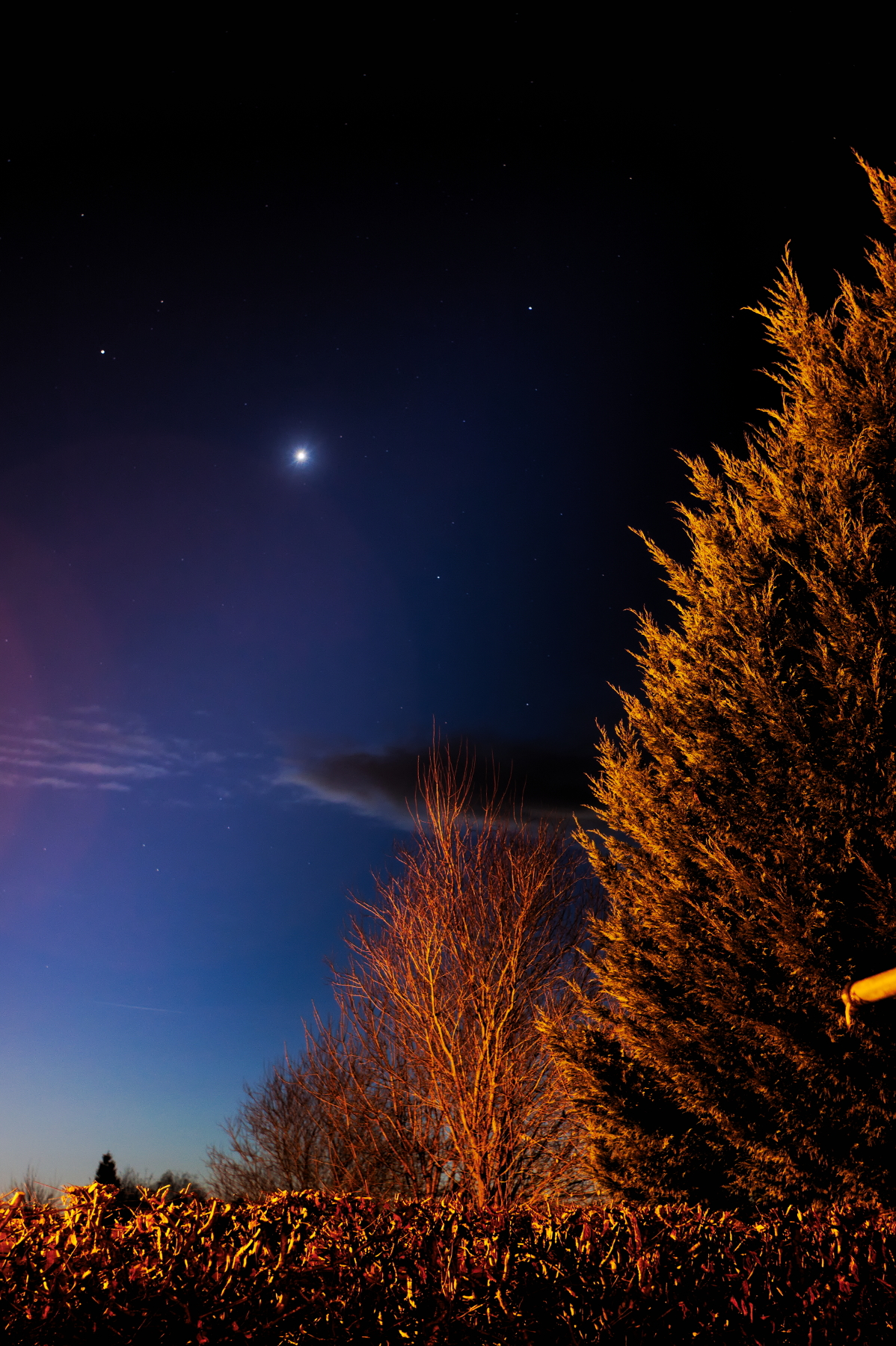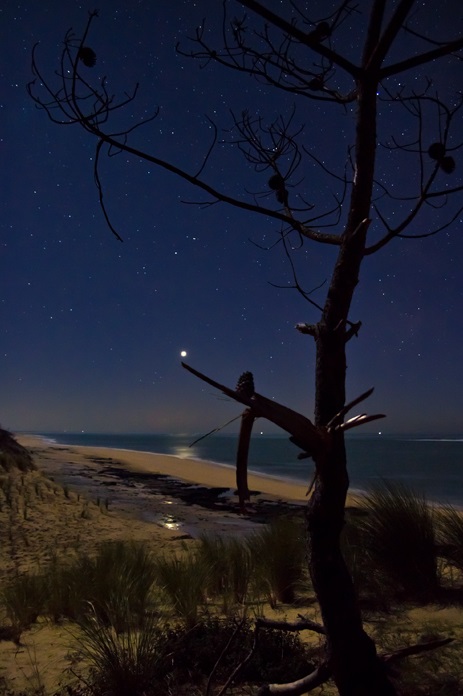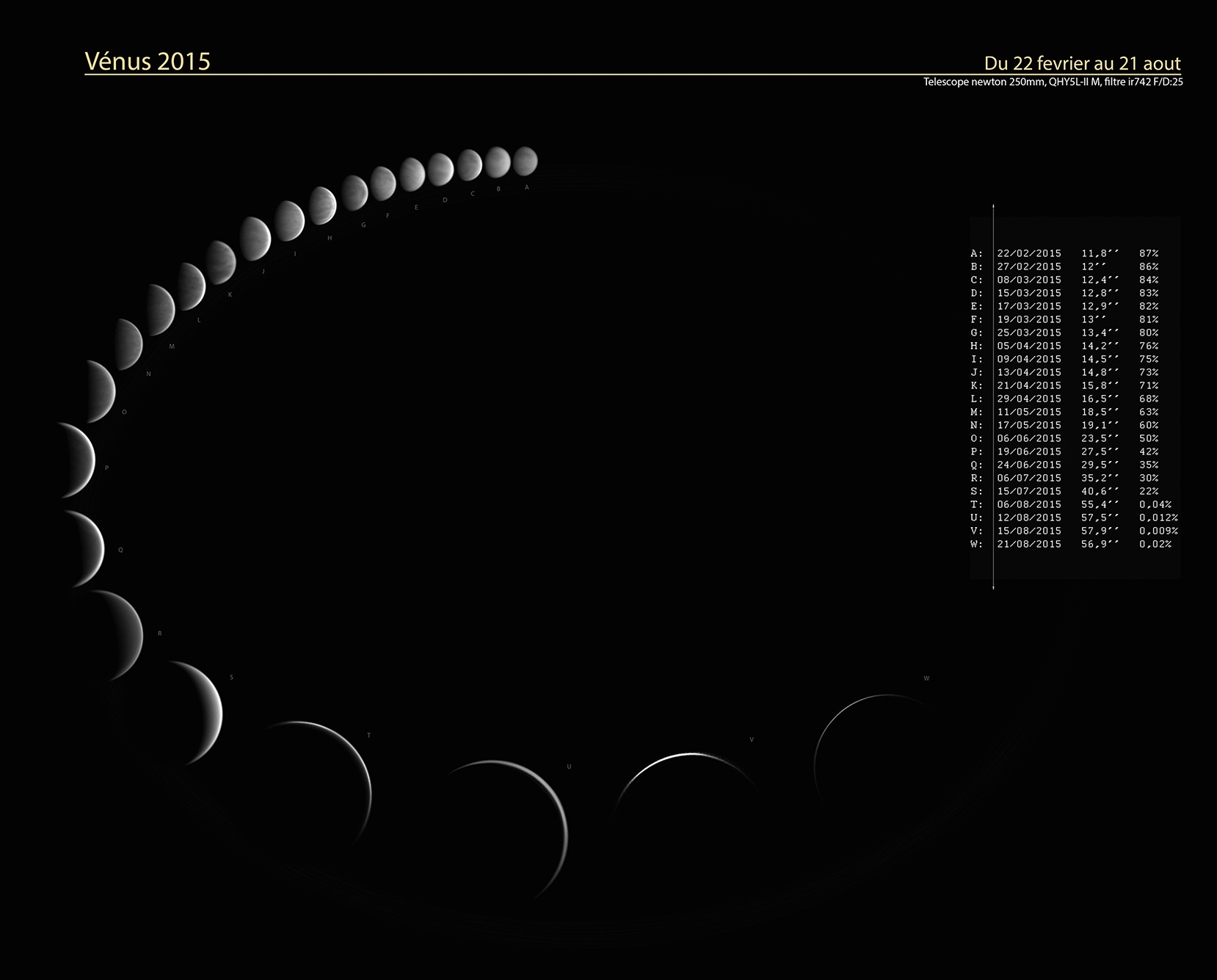You have most likely noticed some evenings in the west and some mornings in the east the bright planet of Venus. A genuine night-light of the sky, this celestial body shines brighter than any other star or planet—to such an extent that some confuse it for a UFO! Often called the Morning Star or the Evening Star although it is indeed a planet, Venus gets its name from the Roman goddess of love and beauty. It truly fascinates and captivates, doesn’t it?

Venus’ brightness makes it easy to spot.
Photo: Alain Mathiot
Venus: the brightest celestial object after the Moon and the Sun!
Venus is radiantly illuminated by its relatively close neighbor, the Sun. It is completely shrouded by a layer of clouds that reflect a large portion of the light the planet receives, thus explaining its unique shine.
For those familiar with the magnitude scale, which is the measure of a celestial body’s brightness, Venus often drops below magnitude -4. This luminosity far exceeds that of Sirius, the brightest star in the sky, with a magnitude of -1.5 (for info, smaller numbers and negatives indicate a strong brightness).
But be aware! Venus can be confused with another bright planet. Which one is this? Jupiter, the largest planet in the Solar System. This planet also dominates the sky’s stars during its visibility periods. However, seeing that it is further away, its brightness does not match that of Venus’.
Why is Venus called “the Morning Star” or “the Evening Star?”
Venus shines so brightly that it is the first “star” to appear in the sky after the Sun sets, or the last to disappear before the Sun rises. Its orbital position changes, thus causing it to appear at different times of the night throughout the year. In fact, the ancient Greeks and Egyptians thought that Venus was two separate objects!
It looks like a star with the naked eye, though it is indeed a planet. Unlike stars that emit their own light, Venus reflects the light from the Sun.

Venus’ brightness dominates dusk or dawn
Photo: Thierry Demange, Stelvision Gallery Competition No. 12
Are the Morning Star and the North Star linked in some way?
No! The Morning Star has nothing to do with the North Star, which is favored by navigators because it indicates the North. However, the North Star is not very bright.
What is the best time to observe Venus?
Venus is the second planet closest to the Sun, while Earth is the third. This arrangement makes it impossible for us to see Venus in the middle of the night. This planet never ventures very far from the Sun during its orbit, and can therefore only be seen at dusk or dawn.
Every year, there is a period or two of a few months which make it possible to observe Venus in the best conditions:
- either just after sunset (when it is “the Evening Star”);
- or just before sunrise (when it is “the Morning Star”).

Venus setting over the sea.
Photo: Zapa, Stelvision Gallery Competition No. 7
Contingent on elongation…
If we follow Venus’ and Earth’s positions on their respective orbits, we can see that the distance between the Sun and Venus varies. This is called elongation. If the elongation is small, this means that Venus is close to the Sun. So, when the Sun is set, this planet is also—or it is just above the horizon and can therefore be hidden from us by trees or buildings. On the other hand, when the elongation is greater, Venus ventures further away from the Sun. It is higher up in the sky when the Sun is set, making this the moment when observation is the easiest and the most interesting. The best periods are therefore the months surrounding the dates of Venus’ maximum elongation.
How can I find Venus?
It’s quite easy! When Venus is the “Evening Star,” just look to where the Sun sets (the West), and when it is the “Morning Star,” just look to where the Sun rises (the East). Thanks to its brightness, you cannot miss it! However, it can sometimes be confused for a moment with an airplane, the International Space Station, or certain bright satellites. To figure out which is which, remember that these objects quickly move in the sky, whereas Venus appears immobile.
Is it truly immobile? Yes, if observation lasts only a few minutes. However, Earth’s rotation drags Venus’ visible movement from east to west, like it does with every other celestial body in the sky! Throughout its orbit around the Sun, Venus also changes its place amongst the stars and other planets. Have some fun pointing out its position each week when compared to easily identifiable stars—you’ll be surprised by how quickly it moves!
And of course, you can also verify Venus’ exact position on the Stelvision sky map online.
Observing Venus with the Naked Eye
Venus’ brightness in and of itself can be appreciated without having to use any kind of special equipment. But when this celestial body approaches the Moon or other planets, it is magnified and creates a particularly pretty picture—especially at twilight, with its gorgeous array of hues in the sky.

The reflection of the Moon and Venus.
Photo: Jean-Baptiste Feldmann, Stelvision Gallery Competition No. 7
With a Telescope
Even the most modest of telescopes immediately reveal that Venus does not have the same characteristics of a star. The planet either looks like a disk or a crescent, which is quite interesting to see—one could even say it’s like a miniature Moon!
As for its surface, there is unfortunately not much to see, for Venus is constantly shrouded by thick white clouds which do not reveal any significant details. However, these clouds are what makes Venus shine so brightly and remarkably.

Crédit: Stéphane Gonzales, Stelvision Gallery Competition, No. 12
Observing the Phases of Venus Throughout the Months
The phases of Venus are quite pronounced, and, like the Moon, this planet looks like a gibbous or a crescent. It is nevertheless difficult to see a “full Venus,” for this planet’s disk is completely illuminated only when it is opposite the Sun. Observation at this point is therefore impossible. It’s fun to watch the evolution of the phases of Venus throughout the months, particularly when the crescent begins to thin. The visible changes in size of Venus can also be observed from week to week, as the crescent becomes bigger while it thins out. This is due to the changes in distance between Venus and Earth.

Amateur astronomer Stéphane Gonzales compiled several photos taken of Venus in 2015 to present a model of its evolution over many months. The photos have been placed in a semi-circle, which allows us to understand the changes in size and appearance of the planet. Imagine the Sun in the middle of the ring; it illuminates Venus from different angles seen from Earth. When Venus draws closer to us, its diameter becomes larger as its crescent becomes thinner.
What kind of planet is Venus?
Venus is a rocky planet (also known as terrestrial) and is often considered to be Earth’s “sister planet,” due to its similar chemical composition. Its landscapes are made up of plains, mountains, and volcanoes… This celestial body is also about the same size as our planet, with a diameter of 12,104 km (7,520 miles), or .95 times that of Earth’s.
However, resemblance stops there! Venus’ conditions are hellish, for not only do temperatures reach up to 500 °C (932 °F) as a result of greenhouse gases, but its atmosphere is a particularly unbreathable blend. Made up mostly of carbon dioxide and nitrogen, with just a touch of sulfuric acid, hydrochloric acid, and even sulfur, this planet is most definitely not the first you’d like to visit one day!

Computer-generated image of the Maat Mons volcano from data provided by American Magellan mission’s radar instrument in 1992. Maat Mons reaches up to 8 km (4.9 miles) above Venus’ average surface..
Crédit: NASA / JPL